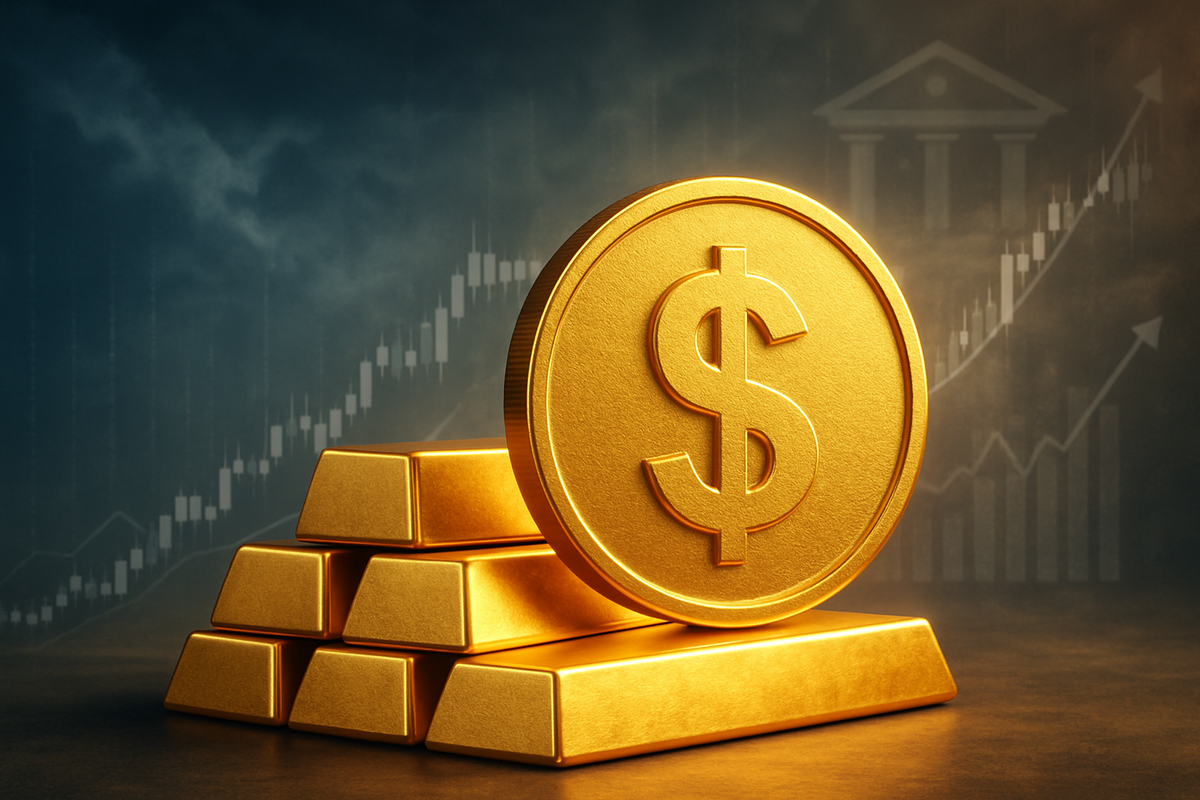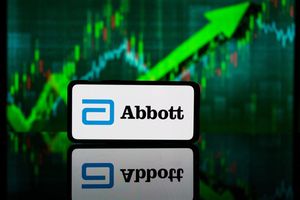
October 16, 2025 - Gold prices have shattered all previous records, surging past the $4,300 per ounce threshold to establish a new all-time high. This monumental rally, observed across global financial markets, is primarily fueled by mounting expectations of aggressive interest rate cuts from the U.S. Federal Reserve and an intensified global demand for safe-haven assets amidst a landscape of escalating geopolitical tensions and economic uncertainties. The precious metal's ascent signifies a profound shift in investor sentiment, reflecting a collective move towards tangible assets in an environment perceived as increasingly volatile and unpredictable.
The immediate implications of this historic surge are reverberating throughout the financial ecosystem. For the market, it underscores a robust investor confidence in gold as a reliable store of value, prompting a significant reallocation of capital away from traditional assets like equities and bonds. This shift is also exerting downward pressure on the U.S. dollar, making gold more attractive to international buyers, while simultaneously driving other precious metals, such as silver, to their own record highs. On a broader economic scale, gold's record-breaking performance serves as a stark indicator of underlying economic fragility and persistent inflationary concerns, even as central banks contemplate easing monetary policy to stimulate growth. Furthermore, it highlights the tangible economic costs of ongoing geopolitical risks and domestic political impasses, acting as a clear barometer of global anxiety.
An Unprecedented Ascent: Dissecting Gold's Historic Rally
The ascent of gold prices to an unprecedented $4,300 per ounce on October 16, 2025, marks a truly historic moment in financial markets. This remarkable surge represents an over 54% gain in 2025 alone and nearly a 100% increase since early 2024, pushing the precious metal far beyond its inflation-adjusted peak of $3,590 (in today's dollars) from January 1980. The rally, which saw gold's market capitalization jump by an astonishing $300 billion overnight as it crossed the $4,250 mark, has been building momentum over several years. Key milestones in this trajectory include breaking past $2,135 in late 2023, surging to $3,000 by mid-March 2025, and peaking at $3,500 in April 2025 amidst unpredictable U.S. trade policy. The final push above $4,000 and subsequently $4,300 in October 2025 reflects an accelerated confidence in gold's enduring value.
This extraordinary rally is underpinned by a confluence of powerful drivers. Geopolitical instability remains a primary catalyst, with ongoing conflicts in Europe and the Middle East, simmering US-China trade tensions, and the prolonged Israel-Hamas war consistently channeling investors towards gold as a quintessential safe-haven asset. Simultaneously, central banks globally have emerged as formidable buyers, aggressively accumulating gold reserves to diversify away from the U.S. dollar, hedge against currency volatility, and bolster monetary sovereignty. Countries like China, Turkey, India, and Poland have been particularly active, with central bank purchases reaching a record 1,136 tonnes in both 2022 and 2024, creating a robust structural demand floor for the metal.
Further fueling gold's ascent are persistent economic uncertainties and inflation concerns. Despite central bank efforts to tame rising prices, inflation remains stubbornly above target levels in many major economies, coupled with anxieties over sovereign debt and sluggish growth. In this environment, gold's traditional role as an inflation hedge and store of value has been significantly amplified. The weakening U.S. dollar, dropping nearly 10% in 2025, has also played a crucial role, making dollar-denominated gold more affordable and attractive for international buyers. Moreover, market expectations of further interest rate cuts by the Federal Reserve, with traders pricing in a near-certain 25-basis-point cut this month and another in December, have made non-yielding gold increasingly appealing compared to lower-yielding bonds and cash.
The market's initial reaction to gold breaching $4,300 has been overwhelmingly bullish. Analysts are largely optimistic, with some forecasting prices to reach $4,400 by year-end and even $4,600 by mid-2026, and Goldman Sachs (NYSE: GS) projecting $4,900 by the end of 2025. This sentiment has translated into significant investor inflows into gold Exchange-Traded Funds (ETFs), with the World Gold Council reporting record monthly inflows in September 2025. Gold mining companies are poised for substantial benefits, as their profitability often magnifies during bull markets. While concerns about potential short-term corrections due to "overbought" conditions exist, these dips are often seen as opportunities for fresh buying. Notably, the Shanghai Gold Exchange (SGE) has solidified its position as a dominant force, capturing approximately 40% of global open interest, signaling a discernible shift in market power towards Eastern financial hubs.
Corporate Fortunes in Flux: Winners and Losers in the Golden Era
The unprecedented surge in gold prices to above $4,300 per ounce has sent ripples through various public companies, creating distinct winners and those facing significant challenges. Gold mining companies, in particular, stand as the clearest beneficiaries of this rally. With gold prices climbing by nearly 57% over the past year and an impressive 16% in the last month alone, miners experience substantial increases in profitability and cash flow due to operational leverage. As the revenue per ounce extracted skyrockets, many fixed and variable costs remain relatively stable, leading to disproportionately higher profit margins, enhanced financial flexibility, and the impetus to expand exploration and development efforts.
Among the prominent gold producers poised for considerable gains are industry titans such as Newmont Corporation (NYSE: NEM), the world's largest gold miner, which is set to see substantial revenue and profit margin increases, especially following its acquisition of Newcrest. Similarly, Barrick Gold (NYSE: GOLD), Agnico Eagle Mines (NYSE: AEM), Kinross Gold (NYSE: KGC), and Alamos Gold (NYSE: AGI) are expected to report robust earnings growth. While the outlook is largely positive, these miners are not without risks, including potential operational setbacks, geopolitical instability in their mining regions, and the ever-present challenge of rising input costs like energy and labor, which could temper some of the profit expansion.
Conversely, public jewelry companies generally face headwinds from these soaring gold prices. Gold is a primary raw material for their products, meaning higher prices translate directly into significantly increased production costs. This forces jewelers to either absorb the higher costs, thereby squeezing profit margins, or pass them on to consumers, which can dampen demand, especially in price-sensitive markets. Major retailers like Signet Jewelers (NYSE: SIG), which operates popular brands such as Kay Jewelers and Zales, will contend with these elevated input costs. In regions like India, where gold holds immense cultural significance, local retail chains have already reported a drop in consumer deposits for deferred gold purchase schemes as customers reduce purchase volumes due to the prohibitive cost. Jewelers are increasingly exploring strategies to adapt, such as focusing on lighter-weight designs, higher-purity items, or incorporating more gemstones and alternative metals to mitigate the impact of costly gold.
Investment funds focused on precious metals are also significant winners in this environment. Gold-backed Exchange-Traded Funds (ETFs) like SPDR Gold Shares (NYSEARCA: GLD) and iShares Gold Trust (NYSEARCA: IAU), which hold physical gold, directly benefit from the metal's appreciation, having seen substantial gains (GLD over 50% in the past year, IAU over 55% YTD 2025). Furthermore, gold mining ETFs such as VanEck Gold Miners ETF (NYSEARCA: GDX) and VanEck Junior Gold Miners (NYSEARCA: GDXJ) offer leveraged exposure to gold prices, often outperforming physical gold during sustained rallies due to the operational leverage of the underlying mining companies. GDX, for example, returned approximately 134% in 2025, while GDXJ delivered a 146% return. These funds attract increased investor capital seeking a hedge against inflation and economic uncertainty, though they carry risks associated with company-specific factors and higher volatility.
Beyond the Metal: Wider Implications of Gold's Ascent
The surge of gold prices past $4,300 per ounce carries profound wider significance, reshaping industry trends and sending ripple effects across global financial landscapes. Within the gold mining sector, this historic price point translates into significantly expanded profit margins, incentivizing companies to ramp up production, explore new deposits, and potentially reopen previously uneconomical mines. This environment is ripe for increased exploration budgets and heightened merger and acquisition (M&A) activity as firms seek to consolidate assets and capitalize on favorable valuations. However, challenges persist, including declining ore grades, rising extraction costs, and stringent environmental regulations, which continue to test the industry's capacity to scale supply.
In the jewelry market, the impact is a direct increase in the retail price of gold items, which could temper consumer demand, particularly in price-sensitive regions like India and China. Consumers may gravitate towards lighter-weight or higher-purity gold products, minimalistic designs, or increasingly, towards the burgeoning markets for estate jewelry and gold recycling, as they look to capitalize on high prices or repurpose existing pieces. This shift in consumer behavior is prompting jewelers to innovate their offerings and potentially focus on value-added services. Meanwhile, in broader financial markets, gold's sustained rally reinforces its critical role as a portfolio diversifier and a quintessential safe-haven asset, attracting substantial investment inflows into gold-backed Exchange-Traded Funds (ETFs) and solidifying its position as a hedge against inflation and geopolitical risks, despite recent unusual trends where its correlation with equities has sometimes defied historical norms.
The ripple effects extend to competing assets and global partners. While silver, rare earth elements, and even cryptocurrencies like Bitcoin (CRYPTO: BTC) offer alternative avenues for wealth preservation, gold's established track record and lower volatility generally maintain its premier status. Crucially, the actions of central banks globally represent a monumental ripple effect. Their unprecedented pace of gold accumulation, exceeding 1,000 tonnes annually in recent years, is driven by a strategic imperative to diversify away from the U.S. dollar, hedge against currency volatility, and enhance monetary sovereignty. This "de-dollarization" trend provides a robust structural demand floor for gold, fundamentally altering its position in the global monetary system. Furthermore, a weaker U.S. dollar and expectations of dovish monetary policy from the Federal Reserve continue to bolster gold's appeal to international buyers and investors seeking non-yielding assets.
From a regulatory and policy perspective, the sustained high prices and increased trading activity could prompt new reporting requirements or trading restrictions in various jurisdictions. Central bank monetary policies, particularly regarding interest rates, remain pivotal drivers of gold's valuation. Historically, gold has consistently proven its worth during periods of economic turmoil, such as the 1970s stagflation, the 1980 peak (which, adjusted for inflation, was surpassed by April 2025 prices), the 2008 financial crisis, and the COVID-19 pandemic. However, the current rally is distinct. It is characterized by a continuous, almost uninterrupted surge, an unusual co-movement with equity markets, and the sheer scale of central bank buying, which many analysts view as a "Great Gold Repositioning" rather than a cyclical fluctuation, signaling a long-term re-evaluation of gold's role in the global financial architecture.
The Golden Horizon: What Lies Ahead for the Precious Metal
Following its historic breach of the $4,300 mark, the trajectory for gold in both the short and long term remains a focal point of intense market speculation. In the immediate future, gold is largely anticipated to maintain its bullish bias, potentially trading within a range of $4,200 to $4,270, with momentum suggesting further upside towards $4,300-$4,500 if key support levels hold. However, the rapid ascent has pushed gold into "overbought" territory across various technical indicators, raising the specter of a short-term correction or consolidation period as profit-taking ensues. Despite this, the underlying bullish trend is expected to remain robust, with any dips likely to attract renewed buying interest, reinforcing the metal's fundamental strength. Looking further out, the long-term outlook is overwhelmingly optimistic, with major financial institutions like Goldman Sachs (NYSE: GS) projecting gold to reach $4,900 per ounce by December 2026, and others, including Bank of America (NYSE: BAC) and Societe Generale (EPA: GLE), forecasting a potential $5,000 target. Some even envision gold soaring to $10,000 by 2030 under extreme scenarios.
This sustained long-term optimism is anchored in a powerful alignment of structural drivers. Continued expectations of aggressive interest rate cuts by the U.S. Federal Reserve, with markets pricing in multiple cuts through 2025 and 2026, are set to weaken the dollar and reduce the opportunity cost of holding non-yielding gold. Persistent geopolitical tensions, renewed U.S.-China trade friction, and ongoing economic uncertainties continue to fuel safe-haven demand. Crucially, central banks globally are engaged in an unprecedented gold accumulation spree, driven by de-dollarization efforts and a strategic diversification of reserves, providing a formidable structural demand floor. Investors are adapting to this new paradigm, increasingly viewing gold not merely as a safe haven but as a core macro asset for diversified portfolios, while gold mining companies are pivoting towards organic growth and strategic acquisitions to capitalize on their enhanced profitability.
For investors, this environment presents both compelling opportunities and notable challenges. The primary opportunity lies in the potential for continued price appreciation, offering a valuable hedge against inflation and market volatility. Gold-backed ETFs (e.g., SPDR Gold Shares (NYSEARCA: GLD), iShares Gold Trust (NYSEARCA: IAU)) and shares of gold mining companies (e.g., VanEck Gold Miners ETF (NYSEARCA: GDX)) remain viable avenues for exposure. However, challenges include the inherent risk of short-term corrections due to overbought conditions, the possibility of a stronger U.S. dollar, or a de-escalation of global conflicts that could diminish gold's safe-haven premium. A more hawkish stance from the Fed than currently anticipated could also weigh on prices. While the most likely scenario points to a sustained bullish rally, a period of consolidation followed by further gains remains a strong possibility, solidifying gold's evolving role as a central component of global investment strategies.
The Golden Age: A Concluding Assessment and Investor Outlook
Gold's unprecedented surge past the $4,300 mark represents a pivotal moment in global finance, driven by a powerful confluence of factors that have reshaped investor sentiment and strategic allocations. The key takeaways from this historic rally underscore a world grappling with heightened geopolitical instability, persistent economic uncertainty, and a palpable fear of inflation. These concerns have been exacerbated by intensified US-China trade tensions, ongoing conflicts, and domestic political impasses, all fueling a robust flight to safety. Crucially, the aggressive accumulation of gold by central banks worldwide, coupled with the anticipation of further U.S. Federal Reserve rate cuts and a weakening U.S. dollar, has provided a formidable and structural demand floor for the precious metal. This collective "debasement trade" reflects a growing skepticism towards traditional fiat currencies and a fundamental re-evaluation of gold's role as a reliable store of value.
Looking forward, the market assessment for gold remains predominantly bullish, albeit with an inherent acknowledgment of potential short-term volatility. While the rapid ascent has pushed gold into technically "overbought" territory, suggesting the possibility of near-term corrections as investors engage in profit-taking, the underlying structural drivers point towards a sustained upward trajectory. This is not merely a cyclical upturn but rather a profound shift in global financial architecture, cementing gold's position as the ultimate safe-haven asset. Its lasting significance lies in the reassertion of its role amidst an erosion of trust in traditional fiat currencies, the accelerating trend of strategic de-dollarization by central banks, and the increasing pressure on policymakers to address the fundamental economic and geopolitical issues that continue to propel gold's appeal.
For investors navigating this new golden era, vigilance and strategic positioning are paramount. In the coming months, it will be crucial to closely monitor central bank monetary policy statements, particularly from the Federal Reserve, for any shifts in interest rate outlooks. Geopolitical developments, including US-China relations and ongoing global conflicts, will continue to dictate safe-haven demand. Furthermore, investors should pay close attention to inflation data, the strength of the U.S. dollar, broader economic indicators, and the consistent flow of capital into gold-backed Exchange-Traded Funds (ETFs). While the long-term bullish narrative appears robust, an understanding of technical analysis will be vital to identify key support levels should any short-term corrections materialize, allowing for informed decision-making in a market increasingly defined by gold's enduring luster.
This content is intended for informational purposes only and is not financial advice






